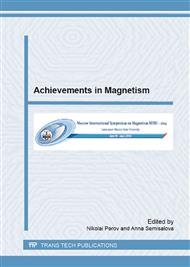p.149
p.153
p.157
p.161
p.165
p.169
p.173
p.179
p.183
Investigation of Hydrothermally Synthesized Greigite Magnetic Properties
Abstract:
Greigite (Fe3S4) is an iron sulfide with inverse spinel structure, same as the structure of magnetite. Half-metallic properties in combination with ferrimagnetic nature of greigite puts this mineral in a fairly narrow group of materials that are potentially suitable for spintronics [1]. In this paper, we have conducted a comparative study of magnetic properties of two crystalline greigite samples obtained by hydrothermal synthesis with different parameters.Conducted Mossbauer spectroscopy study has shown that there are two magnetically non-equivalent B-site iron positions. The interpretation of this result was given using a model for magnetite from [2]. Unusual temperature dependencies of effective magnetic fields for A-and B-site iron atoms were obtained. It was found that coercive magnetic parameters as well as greigite stability depend on the synthesis procedure. Stepwise thermomagnetic analysis in saturating field allowed us to obtain the synthesized greigite critical temperatures of structural stability (T ~ 240oC), after which the sequential process of greigite transformation to pyrite, metastable maghemite (or magnetite) and finally to hematite begins. All of the found greigite peculiarities not only expand the knowledge about this complicated ferrimagnetic phase but can be used as guidance for optimal synthesis conditions.
Info:
Periodical:
Pages:
165-168
Citation:
Online since:
July 2015
Authors:
Price:
Сopyright:
© 2015 Trans Tech Publications Ltd. All Rights Reserved
Share:
Citation:


